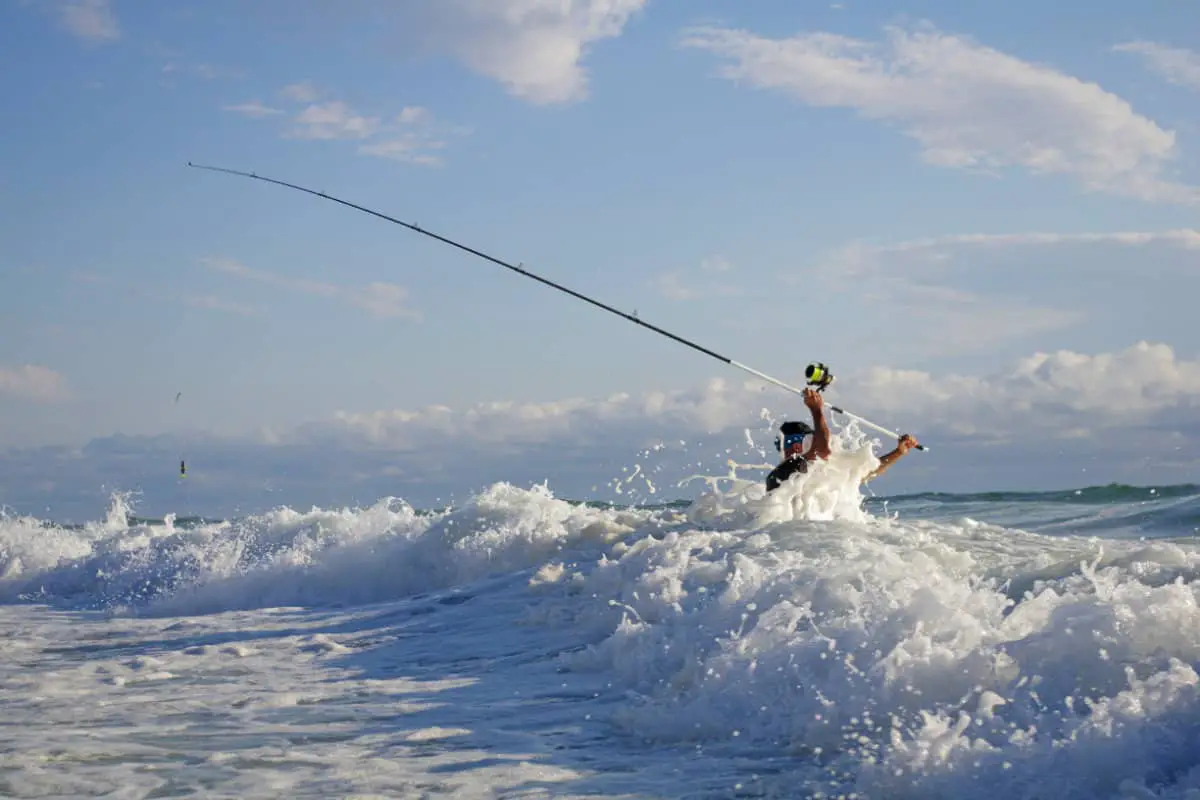I remember reading somewhere that fishing needs to be fun. And if it is not fun, it is not fishing.
And while surf fishing can indeed be mighty fun, it goes without saying that it can also be very dangerous. And there are more than enough reasons for that.
When I started fishing for the first time, I admit, I was not aware of the risks at the time. But with time and experience, I started learning about all the little things that can make surf fishing dangerous.
Is surf fishing dangerous? Surf fishing can be dangerous due to rough weather and water conditions. Lightning strikes, sneaker wavers, fish bites, and strong water currents pose a severe health hazard. Such dangers can be avoided by taking extra care and paying attention to safety.
Below I will go into detail about each of the different aspects of surf fishing that can make it a dangerous activity.
What Are the Dangers of Surf Fishing?
There are several different factors that you need to always keep at the back of your mind when you go surf fishing. Below I will list and go into detail about the most common dangers that you need to know and understand.
Make sure always to place safety in the first place. A fish, no matter how big, is never worth catching if this will put you in danger.
Dangerous Ocean Life
There are a lot of different fish species. And although most of them are harmless, some can be very dangerous.
Whether or not you are casting from the beach or wading into the water, you need to pay extra attention to what lurks in the water.
Sharks
Wading into deeper water calls for extra care as bait can even attract sharks and other predators near you.
Sharks are known to get closer to the beach, even in shallower water. Some anglers say that if the water is deep enough for you to swim, then a shark can swim in it too.
Although shark attacks happen rarely, extra care is advised at all times.
Jellyfish
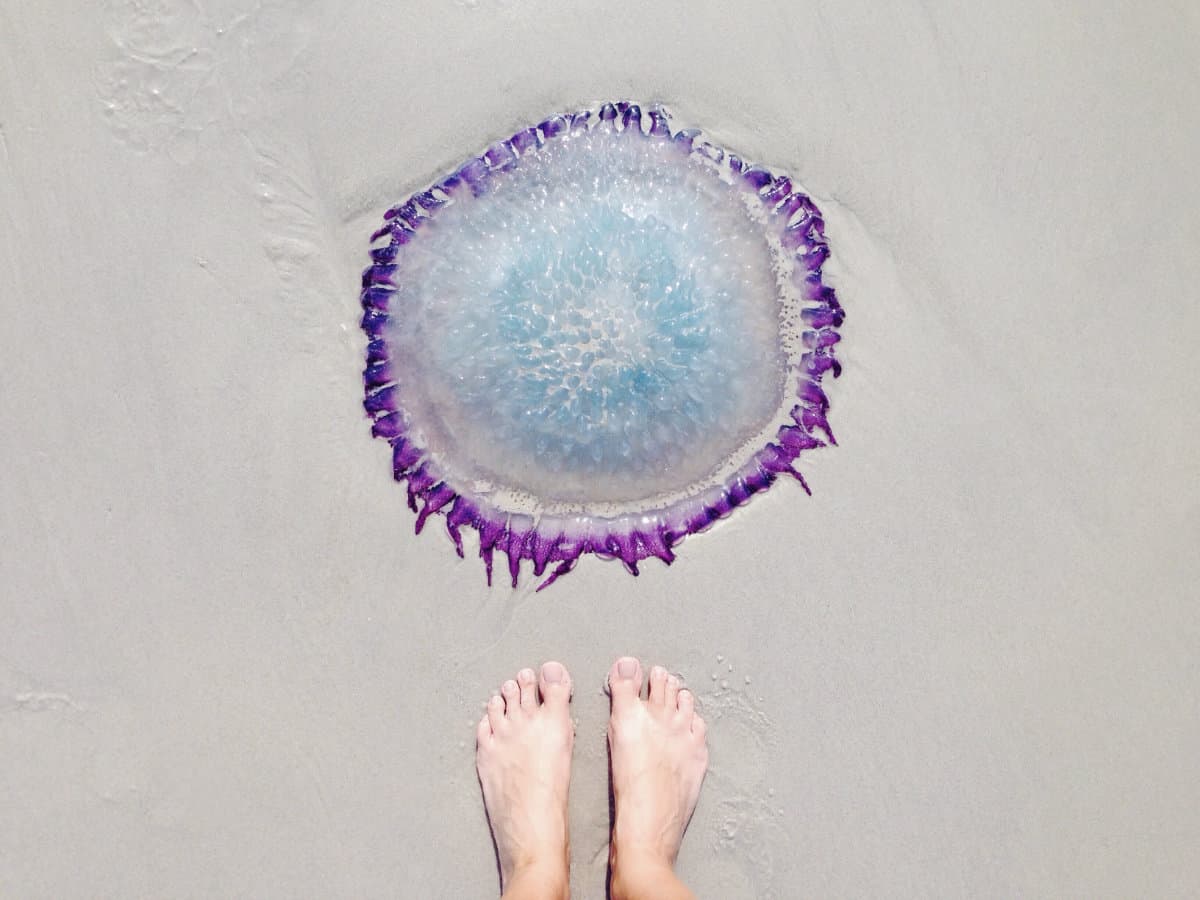
Similarly, you need to exercise extra caution when there are jellyfish nearby.
Jellyfish can produce a very painful sting along with tingling, red rashes, numbness, muscle cramps, and itching. Not all jellyfish stings are dangerous or lethal. However, the stings from certain species of jellyfish (like the box jellyfish) can be deadly.
The stinging bits are fired like tiny darts from the tentacles of jellyfish. These are loaded with a neurotoxin that paralyzes the jellyfish prey.
Jellyfish can also be found washed up on the beach. This does not make them safe as they can still sting you even when they are not alive.
Stingray and Skates
Other fish species that you can encounter are stingrays and skates which look very similar.
Skates can be relatively harmless, although they can bite, and trust me, you don’t want to be bitten by a skate.
Stingrays, on the other hand, have a stinger, which can be very dangerous. Stingrays are considered to be very tame. They usually attack only in self-defense when they feel threatened.
Stingrays and Skates can be found in shallow waters near the beach. Frequently they are very hard to spot in the sand and do not move a lot.
This means that you can potentially scare them off as you are wading into the water and stepping on them, which will result in them attacking you. You can also happen to catch both skates and stingrays on your hooks and lures. Unhooking them is not easy, and extra care is advised.
Bacteria
Now I’d like to point out that not just the animals we can see in the water are dangerous. There is a specific type of bacteria known as Vibrio (frequently referred to as flesh-eating bacteria).
This bacteria thrives in warm saltwater and is more prevalent in the South East Coast, especially during the summer months. However, there are reports of it being found in northern areas even up to Delaware.
The infection happens as a result of open wounds, cuts, bites, which the bacteria can enter the human body through (it can also be swallowed with the saltwater).
If not treated, this infection can be even lethal.
Sneaker Waves
Never underestimate the ocean waves.
Even well-versed anglers have been known to get knocked down by big waves while surf fishing. Waves can build up a lot of momentum very quickly and catch you off guard.
Learn how to read the waves and the beach. This is not only going to make your next fishing trip more productive but can also save your life.
For a great example of how quickly things can happen, check out this video:
Sneaker waves are called that way for a good reason. They occur without warning and can pack a lot of punch. Always stand facing the ocean and never turn your back to it.
If you get knocked down by a sneaker wave, you will not only get soaking wet but also a lot of sand can get into your clothes, weighing you down.
This is very dangerous, especially if you are wearing waders, which, when filled with water, can make your escape very difficult as the water waves drag you down and into the ocean.
Dangerous Current Movements
Rip Currents and Rip Tides
Rip currents are powerful, localized currents of water that move towards the ocean. They are not going to drag you under the water, but just away from the shore.
Rip currents are not affected by the weather so they can occur in both good and bad weather and can happen in many places.
They are dangerous even for experienced swimmers. And because you may be wearing waders and fishing tackle on yourself, escaping a rip current can prove to be extremely difficult.
It takes some time, but learn how to spot and identify rip currents. The easiest way to recognize a rip current is by looking for a few signs:
- Fewer breaking waves;
- Darker water;
- Rippled or foamy water surface floating back to the ocean; and
- Rippled water surrounded by clear patches of water.
There are also structural currents that form around jetties, piers, rocks, and outlet currents that form in the area where streams and rivers flow into the ocean.
Undertows
Undertow is the water current that is created after the waves break on the shore. After the water from one wave breaks, it has to go somewhere, so it runs underneath the next wave.
This creates an underwater current that goes towards the ocean as the current above it goes towards the beach.
One of the major differences between an undertow and a rip current is that the undertow happens everywhere.
Normally the undertows are not very powerful. However, they have been known to be able to sweep people out into the ocean.
Tidal Movement
Many surf fishermen like to fish from rocks, jetties, or headlands. Climbing up onto a rock and fishing from there can be a lot of fun. However, make sure always to know what the tidal movement is. And when the high and the low tides are going to change.
Just because these rocks are above the water now doesn’t mean the conditions cannot change in an hour or two. Do not underestimate the power of the ocean.
Incoming waves can knock you off the rocks. This can be very dangerous. You can fall down and injure yourself. You may also get dragged into the ocean or have difficulty getting back to the beach.
Different tidal timetables can be found in your local tackle shops and even online.
Make sure to know what to expect and adapt to the tidal conditions.
Rock and Cliff Edges
Rocks and cliff edges pose an entirely different hazard on their own. Especially when they are wet, they can be extremely slippery and dangerous.
Be extra careful when climbing on a rock or fishing off of a cliff edge. The edges can start to crumble, taking you down as the earth mass falls down.
Sun and UV Exposure
The sun may be one of your biggest enemies when surf fishing. Usually, the UV rays from the sun are strongest from 10 in the morning up until 4 in the afternoon.
The thing is that water can also reflect the sun making the overall effect from the UV light even stronger.
Make sure to bring with you some sun protection clothing. A neck gaiter (or a daily tube), long-sleeved shirts, and a hat are going to protect you against the harmful exposure to the UV light.
Don’t forget always to have some sunscreen handy. The water and sweat will wash the sunblock off your skin with time, exposing it to the sun. Reapply it every few hours or so.
A good rule of thumb is to take a quick look at the expected UV Index in your area. This will help you be better prepared and can be quickly done by checking out the EPA’s website.
Surf Fishing in the Night
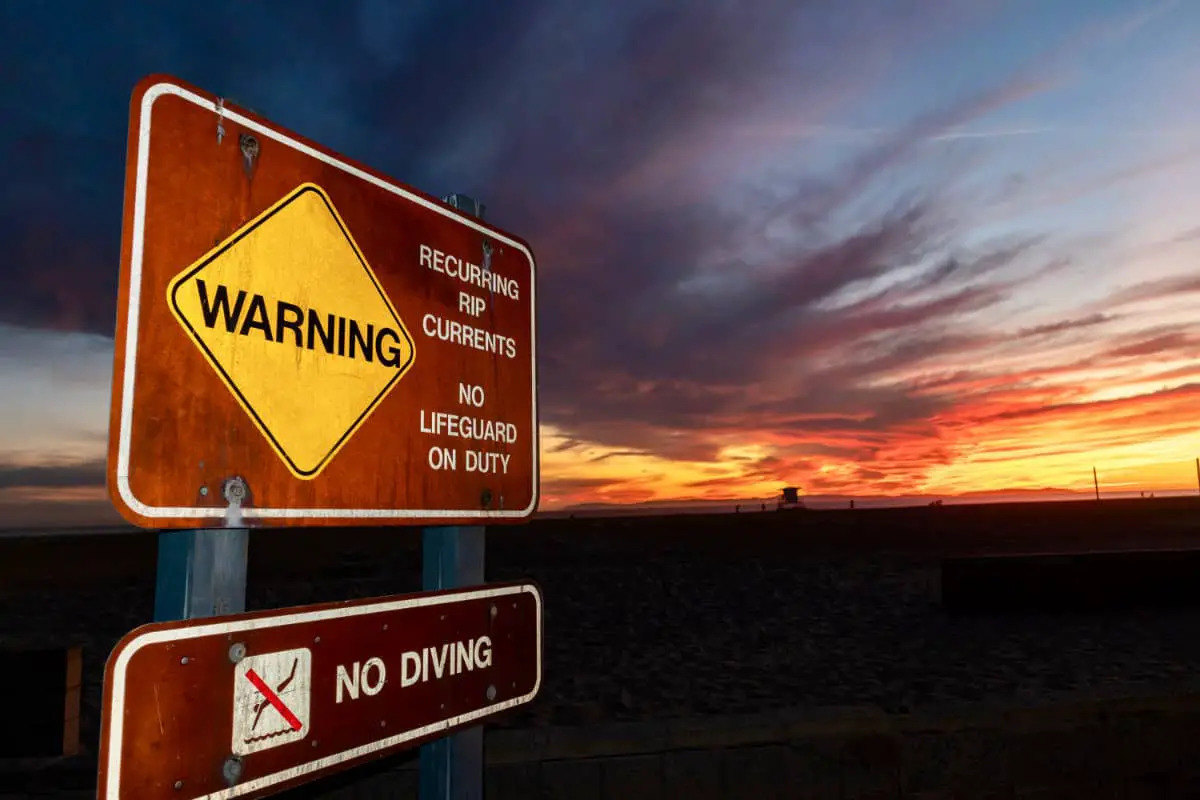
Now that we have covered the day time let’s take a look at the night conditions.
Many anglers enjoy surf fishing at night as it can be very productive if done at the right time.
However, fishing at night can be extremely dangerous as a result of low visibility. And this is going to be our main concern here.
Almost every other hazard that I have listed here is going to be present during the night as well, but with the only problem being – you may not be able to spot it easily.
For example, people may frequently have trouble spotting a sneaker wave during the day, so what are the chances of seeing it during the night? Small, very small.
This calls for extra attention and care while surf fishing during the night. And frequently wading into the water is going to be out of the question.
Lightning Hazards
After taking a look at what the data shows, I found out that fishing was the leading cause of lightning fatalities in the United States.
With that being said, it may come as no surprise to you that the leading state with the most lightning incidents and deaths is, in fact, Florida.
There are various theories as to why that is the case.
Potentially the sound of the surf and the breaking waves can mask the sounds of the incoming storm. Or perhaps many anglers just underestimate the dangers of fishing in stormy weather, especially when you are staying in an open area like the beach.
Harmful Algal Blooms (HABs)
Although HABs normally occur in freshwater, they can happen around both the West and the East Coast and in the Gulf of Mexico around Florida.
This phenomenon happens when toxic algae colonies accumulate in significant quantities.
These are usually known as red or blue tides. They are dangerous and toxic to both humans and animals. The toxicity of the algae is usually fatal to the fish and shellfish, making them unsuitable for consumption.
Getting Hit by Driftwood
Water waves can pack quite the punch. The waves can carry driftwood, parts of logs, and other objects and wash them ashore.
This can be very dangerous as driftwood is often going to be very heavy because of the water. The potential hit from such an object can result in serious injuries.
Be mindful of your surroundings. Avoid surf fishing near any logs and driftwood that have been washed on the beach.
How to Make Surf Fishing Less Dangerous?
Below I will share with you some of the safety tips that I have been following when surf fishing. This can help in making surf fishing a lot less dangerous.
Don’t Go Alone
Ideally, you want to go surf fishing with a buddy of yours. That way, you can keep an eye on each other if things get rough.
If somebody gets knocked down and dragged into the water or gets injured either by a fish or something else, an extra pair of hands and eyes can prove to be priceless.
If you don’t have a buddy to go surf fishing with, you can always try to stay close to other anglers.
Don’t Wade into Deep Water
You don’t have to be in the water to surf fish. Many of the fish species do come close to the shore, and with the right gear and casting techniques, you will be able to catch them.
If you really like wading, generally speaking, I would recommend not going more than knee-deep in the water.
Staying in shallower waters will ensure that in case you get knocked down by a wave or slip and fall, you will not be placing yourself in too much danger and will be able to recover easier.
Always Bring Extra (Dry) Clothes with You
While surf fishing, the chances are that some of your clothes will get wet. Especially if you fish in rougher weather conditions or get knocked down by a wave.
Always bring a pair of extra clothes with yourself. That way, you can change into dry clothes if needed.
Don’t stay in wet clothes for long periods of time. Hypothermia can be quick to set in.
Don’t Go Barefoot
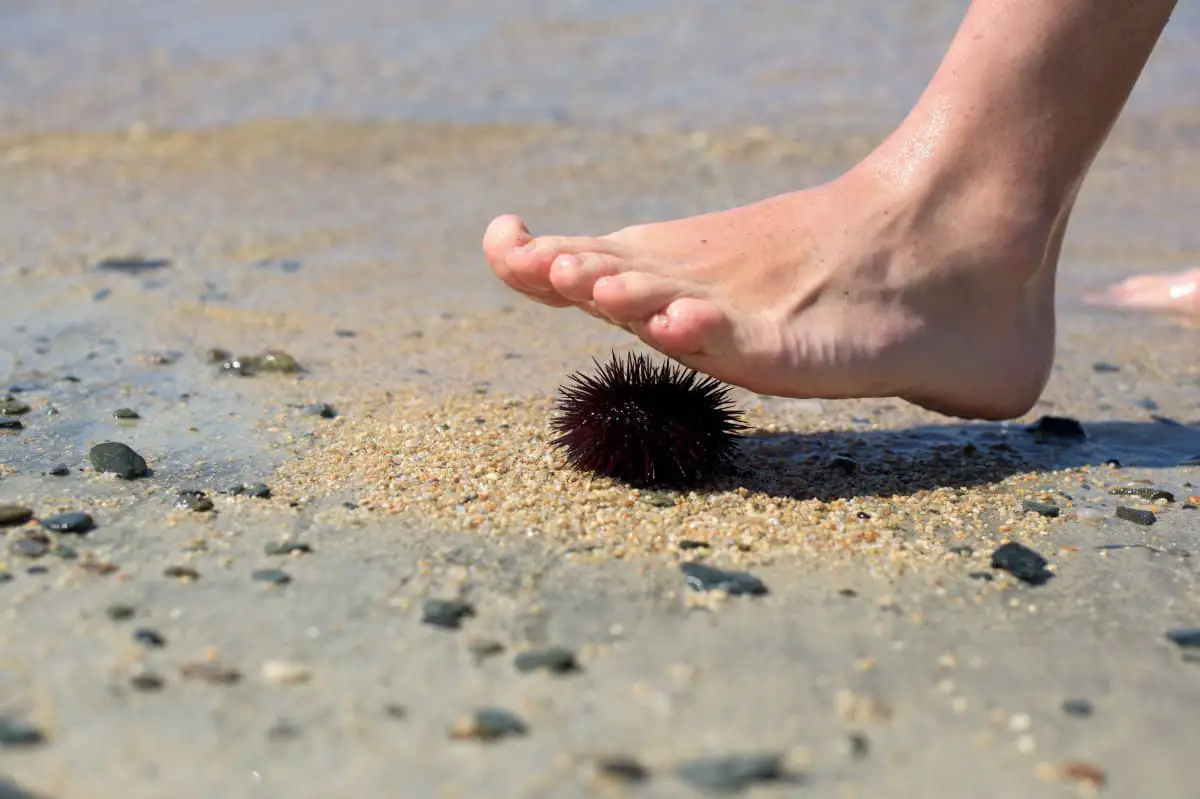
There is nothing more relaxing than a stroll down the beach barefoot.
However, don’t do it if you will be surf fishing and wading into the water. There can be dangerous or broken items in the sand that may hurt your feet. Also, some fish, crabs, and more can get too close for comfort and injure you.
Be Mindful How You Attach Your Bait Bucket and Stringers to Yourself
A lot of the people that like to wade into the water will take their stringers and bait buckets with them and tie them to their waist or belt.
This can pose some dangers when a bigger fish (like a shark, for example) decides to steal your bait bucket or stringer. You can very quickly lose your balance or get dragged around into the water.
Make sure to have your equipment tied to yourself in a way that you can quickly free yourself from it. A slip knot in this situation is both a very practical and easy to tie.
Wear a Life Jacket If Necessary
If you are fishing in very rough conditions with lots of surf, stronger currents and water movement, winds, and or rain, consider wearing a life jacket.
It may not be the most comfortable thing to have on yourself, but it can save your life if it comes down to it.
Or alternatively, avoid surf fishing when the weather conditions are not favorable.
Check the Beach Conditions
Before going on your next surf fishing trip, spend a little time to check what are the beach conditions.
Check information about things like the tide, the expected weather, wind, rain, and the surf height.
This information can easily be accessed online by visiting the websites of the National Weather Service and Tides4fishing.
Keep an Eye on the Weather and Don’t go Surf Fishing in Bad Weather
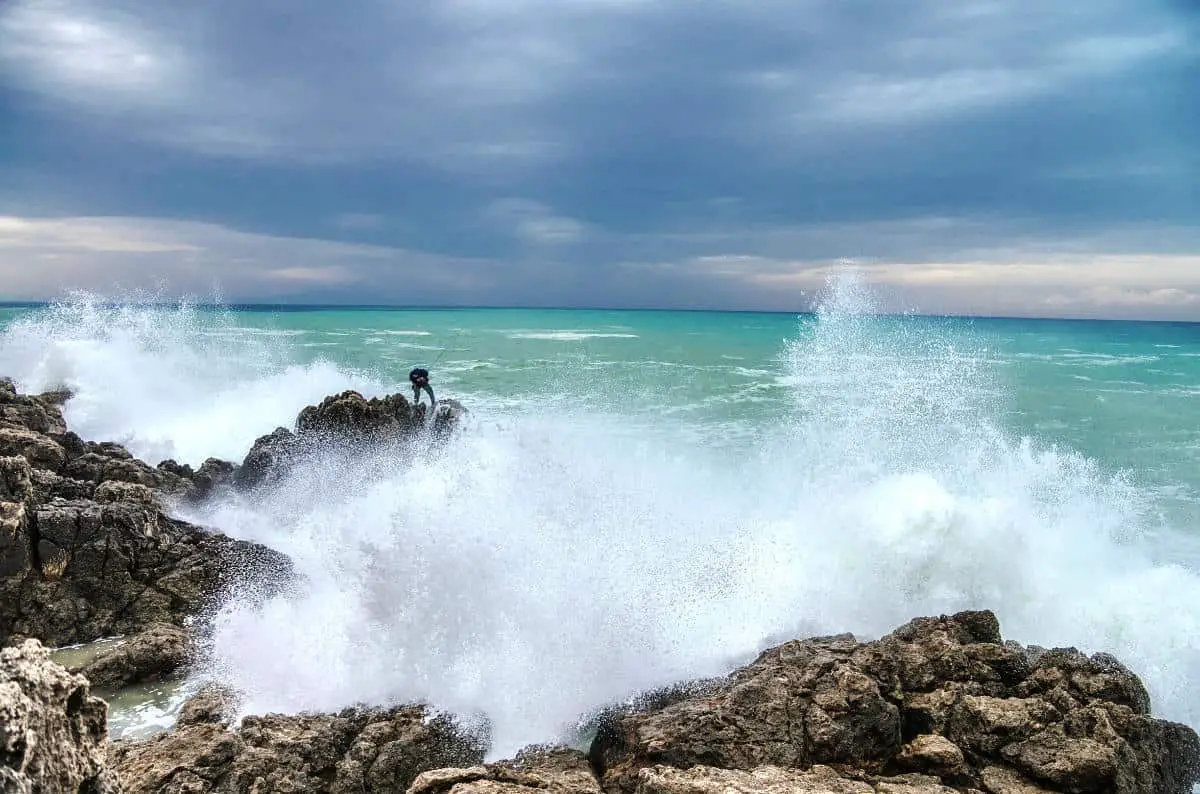
If the weather is bad, it is nor worth going surf fishing. The experience will neither be enjoyable nor productive.
Also, we can easily get carried away while we are fishing. The sounds of the breaking waves can be very relaxing and hypnotic.
However, make sure always to keep an eye on the weather. The weather conditions can change very quickly. Sometimes the storms can come from behind you catch you off guard.
This is dangerous because your vehicle may be far away. And it may take you a lot of time to get your fishing tackle and get to a safe place.
A Few Final Words on the Dangers of Surf Fishing
People have said it before.
A smooth sea never made a skilled sailor.
However, this doesn’t mean that we need to place ourselves in unnecessary danger. As you probably see now, even though we are not going to be fishing in open or deep waters, the oceans and seas should never be underestimated.
The conditions can change literally in the blink of an eye.
If you are in doubt, always choose the safer alternative. The fish will be there tomorrow as well.

